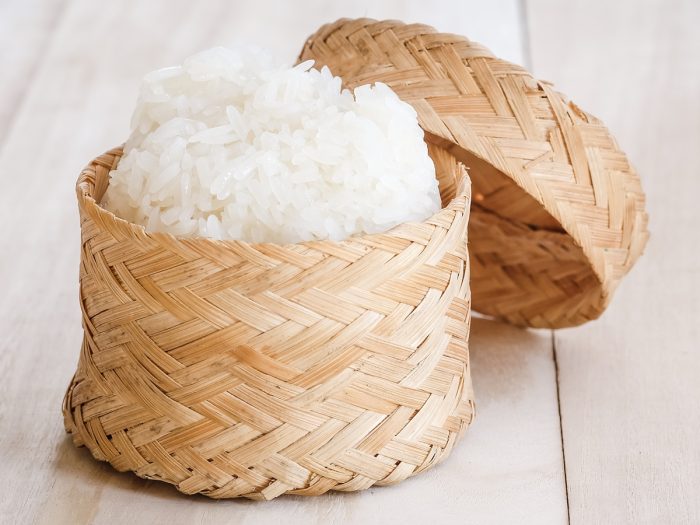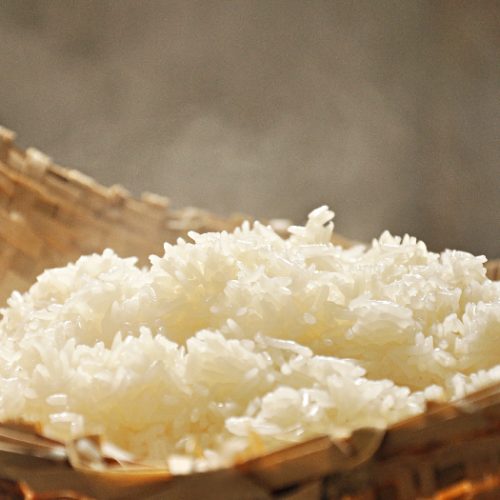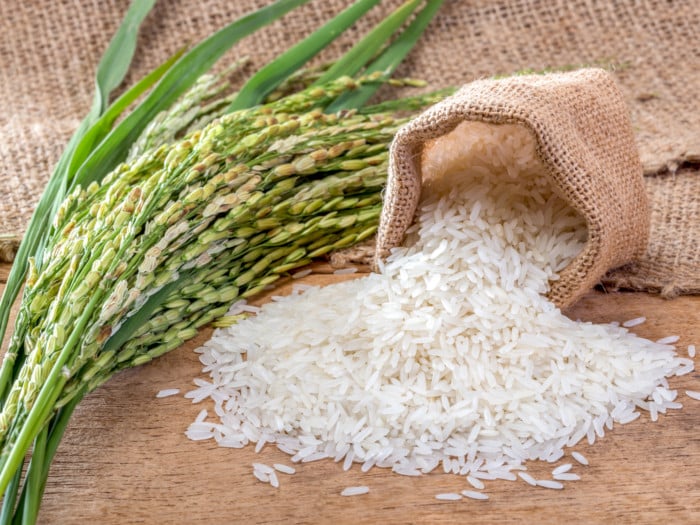Sticky rice is a staple cereal grain in many Asian countries, but it might surprisingly have a large number of health benefits and is increasingly being found in different regions around the world.
What is Sticky Rice?
More formally known as glutinous rice, sticky rice is a particular type of rice that is grown in certain Southeastern Asian countries. The rice grains themselves are uniquely opaque, and they take on a very sticky consistency when cooked. This makes the rice very popular as sushi rice and for other dishes that are traditionally eaten with chopsticks. Although the name glutinous rice makes many people think it contains gluten, this is not the case; the name stems from the glue-like consistency that this rice takes on when it is cooked.
Having been grown for more than 2,000 years in certain parts of Asia, namely China, this type of rice has a very low level of amylose, but a high level of amylopectin, the component that gives the rice its “sticky” texture. Widely used in different ways throughout Asia, it is considered a staple part of diet in Bangladesh, China, Burma, Indonesia, and the Philippines, among others. [1]
| Serving Size : | |
|---|---|
| Nutrient | Value |
| Water [g] | 76.63 |
| Energy | 97 |
| Energy [kJ] | 406 |
| Protein [g] | 2.02 |
| Total lipid (fat) [g] | 0.19 |
| Ash [g] | 0.07 |
| Carbohydrate, by difference [g] | 21.09 |
| Fiber, total dietary [g] | 1 |
| Sugars, total including NLEA [g] | 0.05 |
| Calcium, Ca [mg] | 2 |
| Iron, Fe [mg] | 0.14 |
| Magnesium, Mg [mg] | 5 |
| Phosphorus, P [mg] | 8 |
| Potassium, K [mg] | 10 |
| Sodium, Na [mg] | 5 |
| Zinc, Zn [mg] | 0.41 |
| Copper, Cu [mg] | 0.05 |
| Manganese, Mn [mg] | 0.26 |
| Selenium, Se [µg] | 5.6 |
| Thiamin [mg] | 0.02 |
| Riboflavin [mg] | 0.01 |
| Niacin [mg] | 0.29 |
| Pantothenic acid [mg] | 0.22 |
| Vitamin B-6 [mg] | 0.03 |
| Folate, total [µg] | 1 |
| Folate, food [µg] | 1 |
| Folate, DFE [µg] | 1 |
| Choline, total [mg] | 2.1 |
| Vitamin E (alpha-tocopherol) [mg] | 0.04 |
| Fatty acids, total saturated [g] | 0.04 |
| 14:0 [g] | 0 |
| 16:0 [g] | 0.03 |
| 18:0 [g] | 0 |
| Fatty acids, total monounsaturated [g] | 0.07 |
| 16:1 [g] | 0 |
| 18:1 [g] | 0.07 |
| Fatty acids, total polyunsaturated [g] | 0.07 |
| 18:2 [g] | 0.07 |
| 18:3 [g] | 0 |
| Tryptophan [g] | 0.02 |
| Threonine [g] | 0.07 |
| Isoleucine [g] | 0.09 |
| Leucine [g] | 0.17 |
| Lysine [g] | 0.07 |
| Methionine [g] | 0.05 |
| Cystine [g] | 0.04 |
| Phenylalanine [g] | 0.11 |
| Tyrosine [g] | 0.07 |
| Valine [g] | 0.12 |
| Arginine [g] | 0.17 |
| Histidine [g] | 0.05 |
| Alanine [g] | 0.12 |
| Aspartic acid [g] | 0.19 |
| Glutamic acid [g] | 0.39 |
| Glycine [g] | 0.09 |
| Proline [g] | 0.1 |
| Serine [g] | 0.11 |
| Sources include : USDA [2] | |
Sticky Rice Nutrition
This form of rice does have a unique nutritional profile that may include high levels of protein, as well as roughly 170 calories per cup of cooked rice. There might also be various B vitamins, selenium, zinc, magnesium, copper, and phosphorous. This rice may even contain fiber, but not as much as is found in brown rice and other forms of white rice. There is almost no fat or cholesterol of any kind in this rice. [3]
Sticky Rice Benefits
The health benefits of sticky rice may include its ability to regulate diabetes, prevent chronic diseases, reduce inflammation, and optimize digestion, among others.
May Help Prevent Chronic Disease
Selenium and various other vitamins and minerals in sticky rice may help take on antioxidant properties in the body, which can lower your risk of chronic diseases and reduce oxidative stress in the body. [4]
May Reduce Diabetes
A recent study published in the Asia Pacific Journal of Clinical Nutrition states that eating sticky brown rice for a day may improve glycaemic control in patients with type-2 diabetes which was assessed by continuous glucose monitoring. [5] [6]

A cute litte tin of sticky rice Photo Credit: Shutterstock
May Help Cure Inflammation
The copper, zinc, and B vitamins in this form of rice are known to potentially boost the strength of the immune system, which may help reduce unnecessary inflammation and reduce strain on your system. [7]
May Improve Bone Density
With a variety of essential minerals in sticky rice, this popular variety might help build strong bones and lower your risk of osteoporosis as you age. [8]
May Improve Heart Health
With no fat or cholesterol to speak of, this variety of rice may even be a wise choice for those with heart conditions, high blood pressure, or those struggling with their weight. [9]
May Augment Metabolism
Many of the B vitamins found in sticky rice may be directly tied to the metabolism of the body, including enzyme creation, hormonal balance, and other essential metabolic processes.
How to Make Sticky Rice?
Many people choose to make their own sticky rice at home, which is surprisingly simple if you follow some basic steps.

Basic Sticky Rice Recipe
Ingredients
- 2 cups sticky rice grain
- 4 cups water filtered
- 1/2 tsp salt
Instructions
- Choose a bag of long-grain sticky rice from the store or market.

- Soak 2 cups of rice with 4 cups of filtered water in a pot for 3-4 hours. This will help the rice grains absorb the water.
- Add 1/2 teaspoon of salt and place the pot over high heat and bring to a boil.
- Reduce heat to medium and cover with a lid. Continue cooking for 10 minutes, allowing some steam to vent.
- Do not stir while the rice is cooking. Continue cooking until all the water has been absorbed.
- Serve the rice hot (and sticky!).

Enjoy sticky rice with curries or meat dishes!

